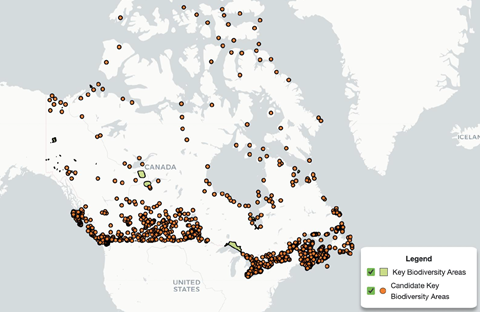
On Monday, October 3rd, guests from conservation organizations, government ministries, foundations and other committed partners gathered at the Canadian Museum of Nature to celebrate the launch of the culmination of years of work – Canada’s Key Biodiversity Areas (KBA) Program, and specifically, the new Canadian KBA Registry. The Honourable Steven Guilbeault, Minister of Environment and Climate Change, spoke to those in attendance and shared his aspirations for the upcoming COP15 and highlighted KBAs as a critical piece for solving the puzzle of how to conserve biodiversity. He extended his appreciation for the exceptional leadership demonstrated by KBA Canada and thanked the representatives present for their pivotal roles. Minister Guilbeault also expressed his pride in Canada being one of the first countries to adapt the global KBA standard to a national context. Importantly, he emphasized that the tool is already being used to inform land use planning, protected areas planning, local stewardship and land use policies.
Guests heard Naomi Kingston, Head of Operations, UNEP-WCMC; Chair of the Key Biodiversity Areas Partnership, speak about the Partnership and Canada’s leadership in building momentum among countries to identify KBAs and create a universal tool. It was also a pleasure to have remarks from David Cooper, Deputy Secretary, UN Convention on Biological Diversity, speaking to this critical time for biodiversity and the positive effect of the huge, collaborative efforts of the KBA program. The highlight of the event was the unveiling and exploration of the new KBACanada.org website and registry. The registry contains important and publicly accessible data on Canadian KBAs that is easy to search and download. The powerful map tool provides a quick visual summary of sites that have met KBA Criteria, as well as candidate sites that are in progress or under review. Visitors to KBACanada.org can discover how they can be involved in Canada’s KBA program as well as learning about the amphibians and reptiles, birds, fishes, fungi and lichens, invertebrates, mammals, non-vascular plants and vascular plants that can be found within each KBA. An exciting outcome of NatureServe Canada’s role in the KBA Canada Coalition is that you can also link to the NatureServe Explorer tool from each KBA information page, create a biodiversity summary report of all species that have been observed within KBA boundaries, and download these species observations.
The KBA Canada Coalition includes NGOs, academic institutions, Indigenous groups, and governments and has been generously supported by funders and experts from across Canada. We are grateful to them all! We also extend our gratitude to RBC Tech for Nature as a major contributor to the work of KBA Canada, including most recently the launch event and development of a short video, Key Biodiversity Areas: Canada’s Critical Places for Nature, explaining KBAs and how they contribute significantly to the persistence of biodiversity.
We’re thrilled with the response so far, but we know this is only the beginning. Thank you once again for your support!

Want to hear more about KBA’s? Listen to the latest episode of Birds Canada’s “The Warblers” podcast to hear Andrew Couturier and Amanda Bichel talk more about these sites and their ties to the IBA program.
What will KBAs mean for conservation in Ontario? Check out this article in the Fall Issue of ON Nature Magazine to learn about how KBAs are fitting into the conservation landscape in Ontario.
KBA Canada is committed to not only putting biodiversity on the map, but to doing this in a way that is meaningful to everyone. Learn about the ongoing collaboration between WCS Canada’s KBA team and the Center for Indigenous Environmental Resources.

The new KBA Canada website is so much more than just a website! It’s a registry of important and publicly accessible data that is easy to search and download. Check out the three main ways to explore this robust set of data.
However you explore, use the Download button to export site data in shapefile or spreadsheet format.
We are always looking for more stories about KBAs and the fascinating species within them. If you have a story about a KBA or a potential KBA species that you’d like to share, write to us at KBA Canada.
As always, please get in touch if you have questions or if you want to learn more.
Peter Soroye
Canada Key Biodiversity Areas Assessment and Outreach Coordinator / Coordonnateur de l’évaluation et de la sensibilisation des zones clés pour la biodiversité